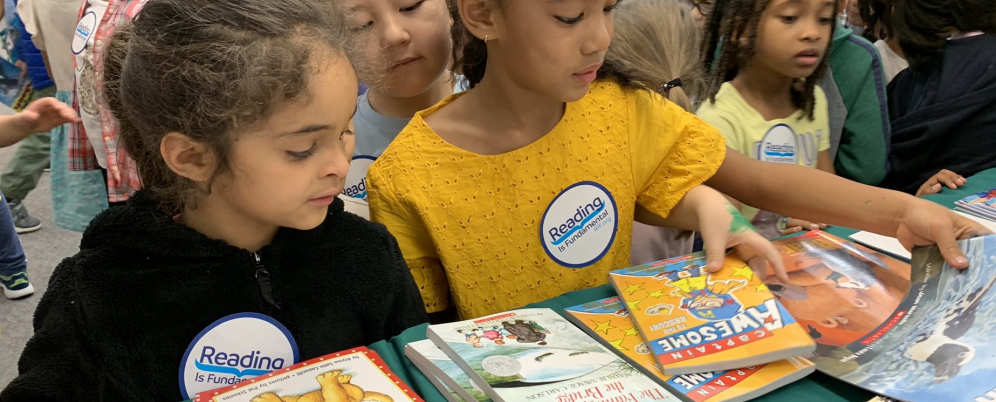Q&A: How Student and Family Engagement Build Strong Readers
As seen on edmentum

This National Reading Month, we’ve connected with a number of educators and literacy experts to ask for their insights on schoolwide strategies, classroom instruction, and ideas to make reading fun. In this piece, we’re sharing a Q&A with Dr. Daris McInnis, Assistant Professor of Literacy at West Chester University of Pennsylvania.
Daris was previously an instructor at the University of Pennsylvania’s Graduate School of Education (Penn GSE) and received his doctorate from Penn GSE’s Reading/Writing/Literacy program. He has also taught PreK and early elementary grades in Washington, D.C., was an Education Pioneer in New Orleans, La., and is a Pat Tillman Scholar who served five years as a commissioned officer on active duty in the United States Army. Additionally, Daris is a member of Reading Is Fundamental’s Middle School Literacy Advisory Board, through which he hosts webinars on out-of-school learning and post-pandemic family literacy efforts, contributes to resources including reading guides for families, and participates in other efforts focused on integrating family engagement into middle school education.
We discussed student motivation and engagement, involving families in literacy, the foundational reading skills for middle school, and the importance of summer learning. Read the Q&A below:
What role do motivation and engagement play in literacy development?
Daris McInnis: There are two key perspectives to consider here: that of the educator and that of the learner. An educator’s mindset and orientation significantly influences student engagement both inside and outside the classroom. When teachers bring enthusiasm to literacy instruction—both for the content itself and for actively engaging their students—it creates a dynamic and inspiring learning environment.
From the learner’s perspective, students are more likely to engage when they see that their teacher is genuinely invested in the lesson. Research also emphasizes the importance of incorporating materials that reflect students’ interests and experiences, such as familiar book characters, representation of their language, or connections to their own communities. These elements help create a more meaningful and engaging learning experience.
When teachers bring enthusiasm to literacy instruction—both for the content itself and for actively engaging their students—it creates a dynamic and inspiring learning environment.
How can family involvement support students’ motivation and engagement?
DM: It’s important to remember that learning happens everywhere, not just in the classroom. That’s why family involvement should begin with schools and learning communities recognizing the vital role that families and caretakers play in a child’s education. Authentic, purposeful involvement should be a collaborative effort. Educators and caretakers must view each other as essential partners in a child’s learning journey.
Since learning is always happening, open communication between families and teachers about what students are learning and observing—both at home and in school—can be incredibly valuable. And meaningful family involvement, in whatever form it takes within a school setting, reassures families that we are genuinely invested in their children's education.
How else can schools involve families in helping students build reading skills?
DM: Schools should consider establishing regular check-in points throughout the academic year and making them a priority on the school calendar. These check-ins could include a “Meet Your Teacher” day before school starts—one of my favorite moments when I taught early grades was getting the opportunity to meet my kiddos and their families a week or so before school began. I remember one student I had in preschool was super shy about going to school. Her dad brought her in a week before class started, and we sat in the dramatic play (kitchen) area of the class and played. Her dad took pictures of us and showed them to her to remind her that school was going to be fun and engaging. I think this helped ease her feelings about starting a new school that wasn’t her daycare, with new teachers and students from the community.
Other valuable check-ins might involve home surveys, home visits, or interviews with families to understand what learning already takes place at home and how it can be integrated into the classroom. Asking questions like “What types of books does your child enjoy?” “How often do you read together?” and “What support do you need from us as a school?” can help build stronger connections between educators and families. Additionally, some schools might benefit from creating a learning contract or setting shared goals for family-school collaboration. Revisiting these goals mid-year and at the end of the year allows for reflection on progress, adjustments as needed, and goal setting for the next grade level. By engaging families in these ways, we gain valuable insights that can enhance student learning.
What foundational reading skills do kids need if they’re going to be successful students in middle school?
DM: Students need to be able to decode unfamiliar words, recognize sight words, and develop a strong vocabulary. Also, just as important, we must foster students’ critical reading and thinking skills, which are often grouped under comprehension. Students should be familiar with analyzing, interpreting, and evaluating texts, whether it’s a paragraph, a full book, or everyday sources like news media. Critical reading involves using critical thinking skills to question not just the text itself, but also our own understanding of it and the world around us.
Encouraging this deeper engagement helps students become more thoughtful, reflective, and informed readers. They learn to engage with complex texts, which include new and complex ideas they encounter while learning in middle school. Reading a wide variety of books provides students with opportunities for critical engagement with texts across various languages and cultures, which is an important element of learning about themselves and others at this critical stage of their education.
Students should be familiar with analyzing, interpreting, and evaluating texts, whether it’s a paragraph, a full book, or everyday sources like news media.
What is the importance of summer learning?
DM: During the summer, many children go for extended periods without school-based learning, which can lead to a need for reinforcement of key concepts when they return. This is closely connected to family literacy and learning beyond the classroom. While summer literacy enrichment doesn’t have to mirror the school year, it’s important to keep children engaged in reading and learning in meaningful ways. This could include joining a book club, visiting the library to participate in summer programs or borrow books, or attending a summer camp that incorporates small literacy activities. However, it’s also important to recognize that access to these opportunities isn’t universal, and some families may face barriers to participation. Finding ways to support all children in maintaining school-based literacy engagement over the summer is necessary.

